Universities: some shrinking, some growing
Fewer freshers but total number of university students increases
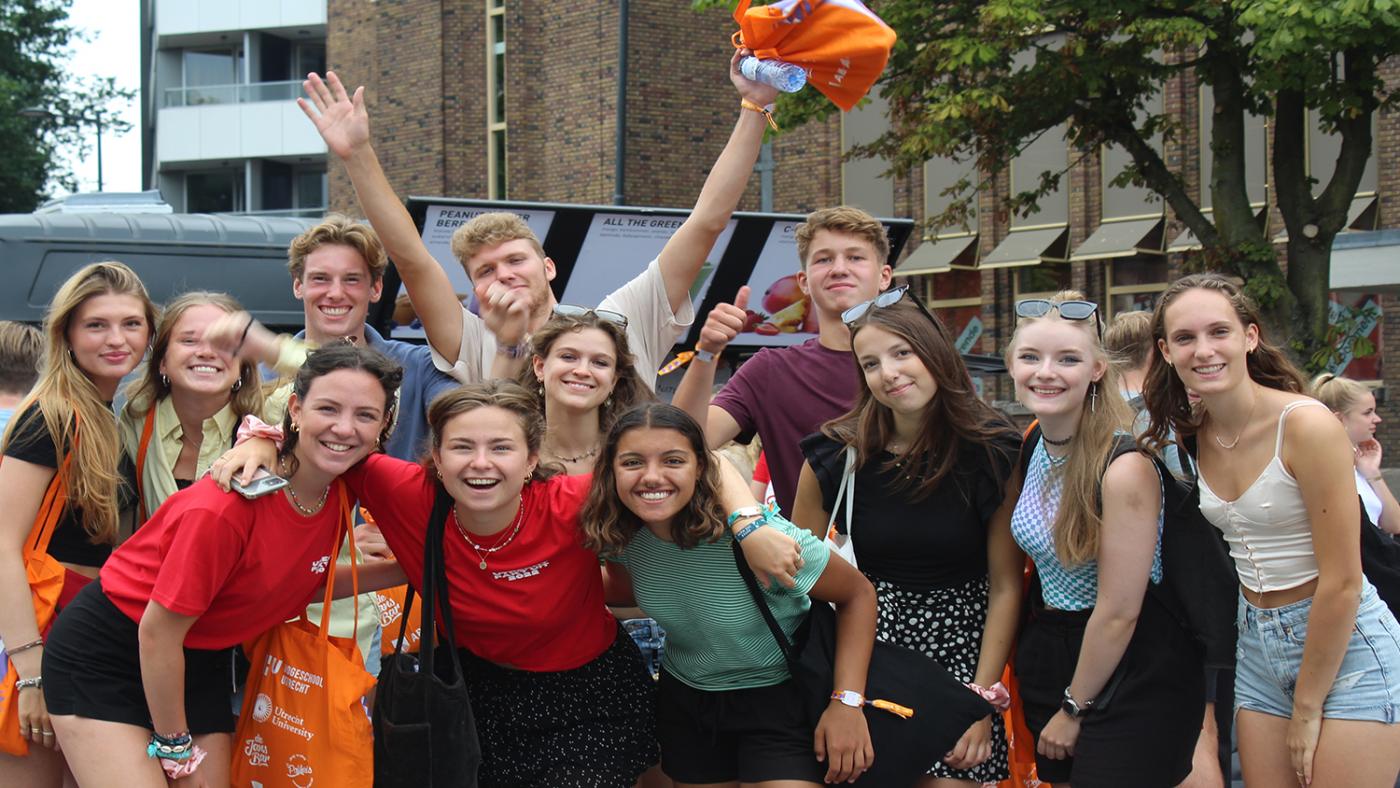
Throughout the Netherlands, 60,000 people started a Bachelor’s at university. 50,000 started a Master’s programme. But the numbers vary greatly between universities. The University of Twente, for example, saw a 24 percent drop in the number of new first-years – more than they had previously announced.
Leiden and Tilburg also saw a 12 and 10 percent drop in new students, respectively, whereas Maastricht (+5 percent) and Eindhoven (+4 percent) grew the most.
There are a total of 13,791 new students at the UU. That’s 300 less than the previous academic year. The number of students that started a Bachelor’s programme increased by 3 percent to 7,850; the number of students that started a Master’s programme dropped by 9 percent to 5,377. 532 people started a pre-Master’s programme, which is 230 less than last year.
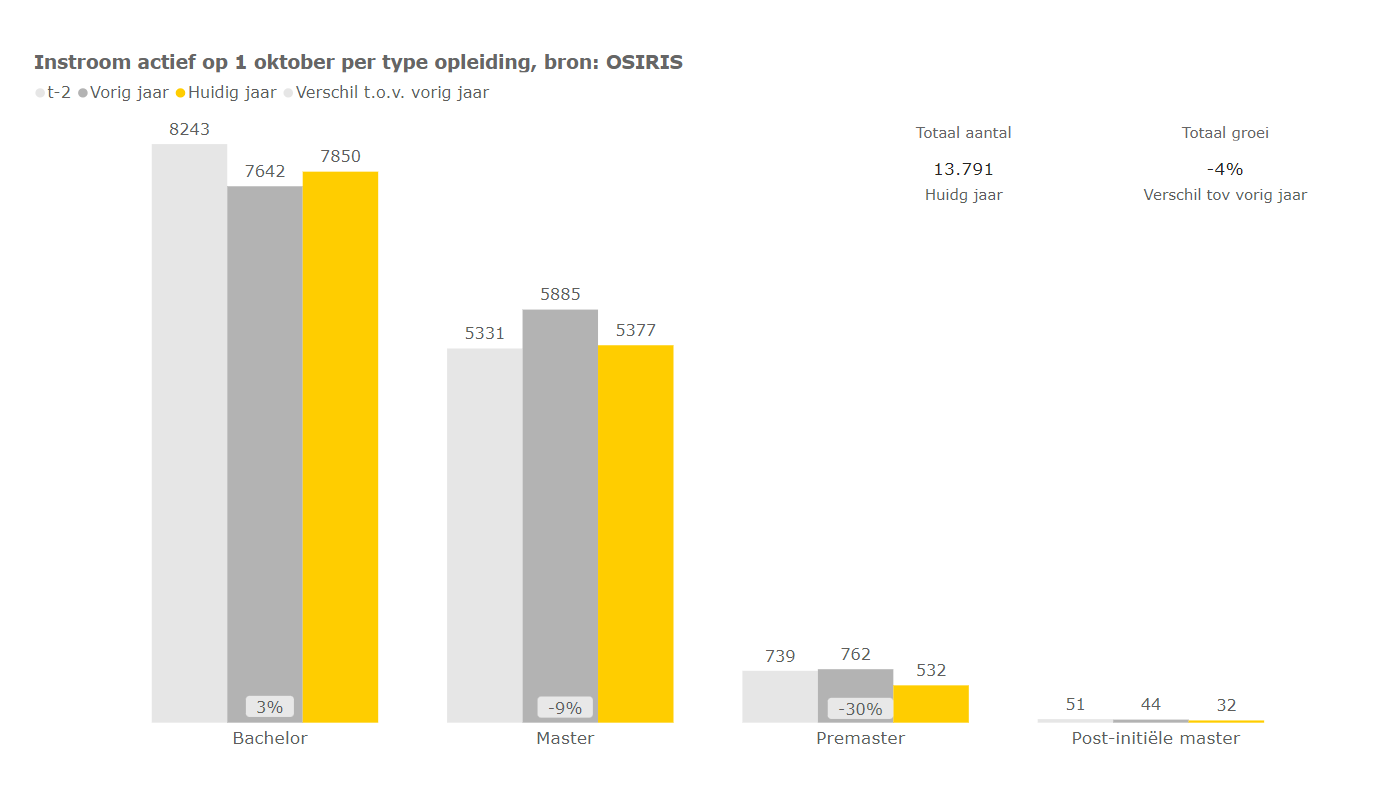
Enrollment figures from Utrecht University, October 2022. These figures are broken down into intake in master's and bachelor's programs, pre-masters and post-initial masters (education for professionals). Source UU
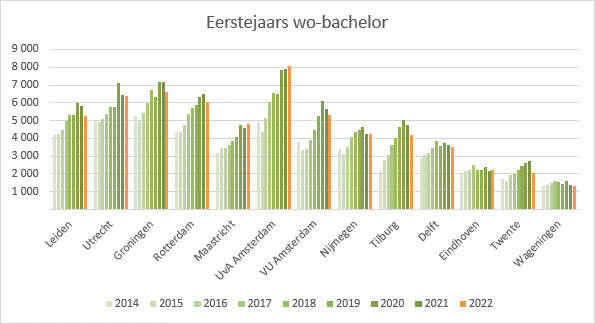
The intake figures of all Dutch universities as registered by the Universities of the Netherlands (UNL). In this table, the intake of students from Utrecht University seems to be lower than last academic year. This is because UNL counts pre-master's students in the intake of bachelor's students. UU received significantly fewer of these this academic year.
Registrations
The total number of registrations, including returning students, barely changes. Nationwide, the universities have just as many students as they did last year – around 340,000. The extreme outliers are the University of Twente (3 percent less) and on the other side, the University of Amsterdam and Utrecht University, which both have 2 percent more registrations. In total, there are 39,762 students registered at the UU this academic year.
This result in Utrecht is caused by the increased influx of students from the past few years, and the number of students who continue their studies here.
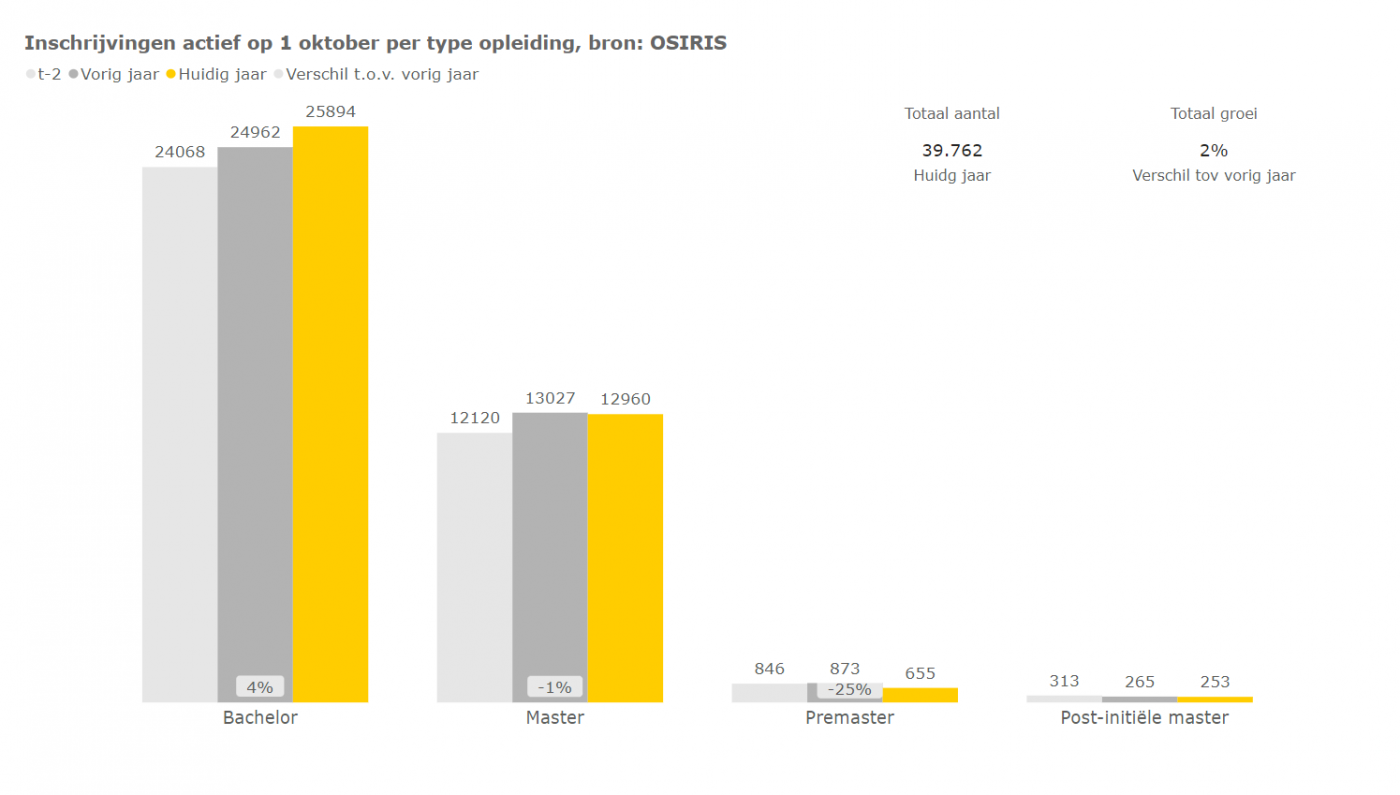
Number of student enrollments at Utrecht University, source UU.
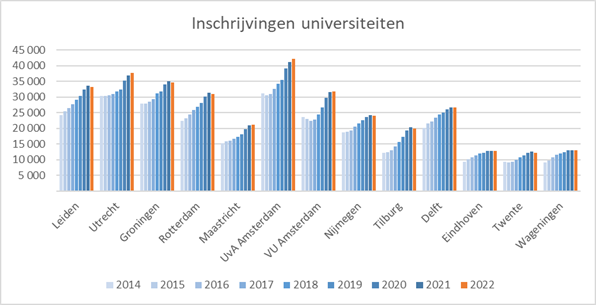
Number of student enrollments at all universities, source Universities of the Netherlands (UNL).
Internationals
The number of international students is still increasing in the Netherlands. This year, more than 85,000 international students are registered at a university. That’s 7.3 percent more than last year. At the moment, around one in three students is from abroad, both in Bachelor’s and Master’s programmes.
Compared to last year, there are more international first-years at Utrecht University as well, a growth of 6 percent, or 2,759 students. That increase is, however, smaller than it was last year. Most internationals are from Germany (92), with Italy (90) in second place. The biggest growth is among students from Romania (plus 38 to 50), and Poland (plus 27, to 71). That one can find in the university council's paper on enrollment 2022-2023 (only accessible with Solis-id).
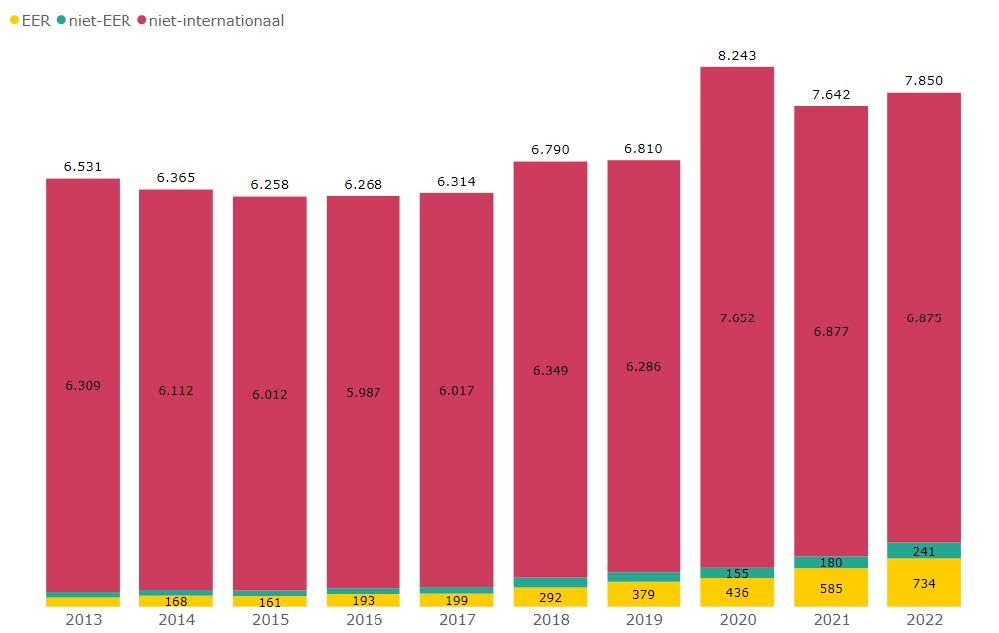
Bachelor's enrollment of foreign students, source UU
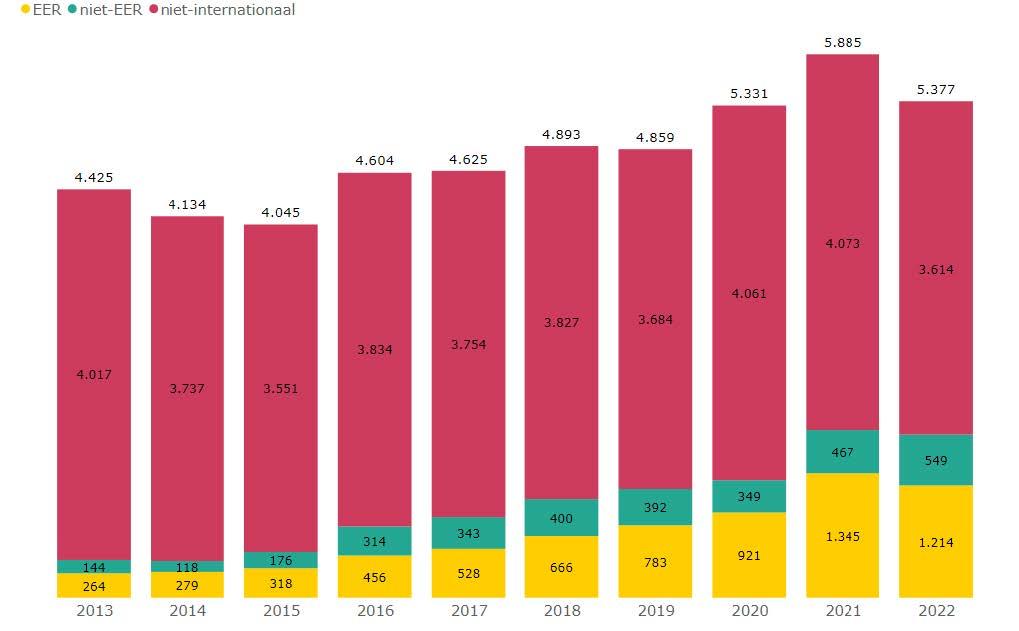
Master's degree enrollment of foreign students, source UU
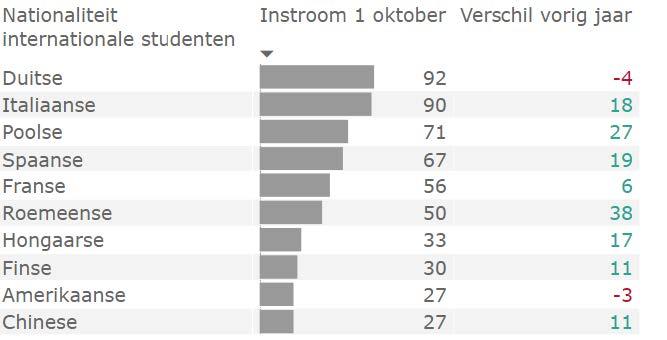
Top 10 countries of enrollment of international students in a bachelor's degree program at UU, source UU
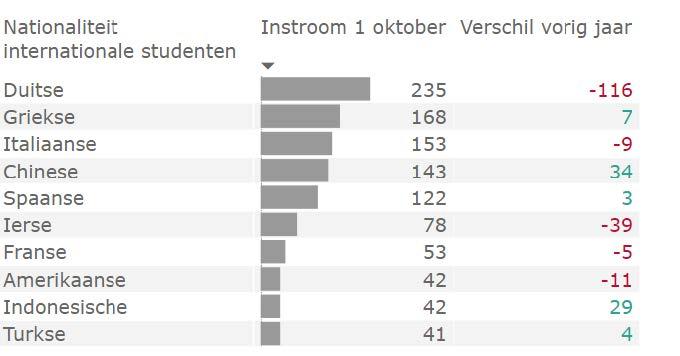
Top 10 enrollment of international students in masters, source UU.
Response from minister
Minister Dijkgraaf responds to the increased number of international students at Dutch universities: “We need to start controlling that influx, in order to reach a better balance in our educational system. We need to capitalise on the benefits of internationalisation, like attracting international talent for the Dutch labour market and society, and reduce the downsides – like issues with high workloads for teachers, and student housing – as much as possible.”
If all goes as planned, he will present proposals this month that are meant to better control that influx. It’s a part of the large-scale exploration of the future that he’s working on. That exploration deals with topics like the decrease of the number of Dutch students, but also with topics like internationalisation, costs, and sectors that are experiencing labour shortages, like health care, education, and technology.
Explanation for UU growth and decrease data
The growth in the UU Bachelor’s programmes is partially explained by an increase in international students, according to the University Council memo. Among international students, programmes like Economics & Business Economics (+100 internationals) and Molecular and Biophysical Life Sciences (+62 internationals) are popular. Interdisciplinary Social Science, Maths, and IT are also showing a “remarkable increase” of 61, 43, and 36 more international students respectively.
The smaller number of students registered for a Master’s programme can partially be explained by the newly implemented maximum of 150 spots in the Clinical Psychology Master, which saw 355 students start their programme last year.
The future
Universities are already anticipating Dijkgraaf’s exploration of the future, they say as the data are announced. They expect to see more growth in the coming years, and are asking for significant changes to the higher education system.
The universities want a system that “makes the budget less dependent on student numbers and market shares,” as chairman Pieter Duisenberg from umbrella organisation UNL says.
At the moment, part of the universities’ financing depends on the number of students that’s registered at a university. The complaint universities have is that the bag of national funds doesn’t grow along with the growth of the student numbers. That means that when student numbers are on the rise, there’s less money per person that goes to the university. So when the student numbers drop, universities don’t want to immediately feel that in their wallets. On the flip side, they want to receive enough money per student when they start growing again, so universities can, for instance, hire new lecturers. In the current system, that isn’t always financially feasible, which means the workloads among staff increase, and the quality of education will be under pressure, they predict.
Utrecht University does not expect a significant increase in student numbers in the next two years, but does expect to see growth after that. That prediction is based on influx prognoses made by DUO, as well as an estimate of the re-registrations in the past.
Universities of applied sciences
The drop in student numbers is heavier in the applied sciences. The universities of applied sciences are attracting fewer freshmen than before Covid, and the expectation is for that trend to continue. Dijkgraaf’s exploration of the future will also take a look at this. Five universities of applied sciences already received funds this year to cushion the drop in student numbers. Starting next year, there will be more funds.